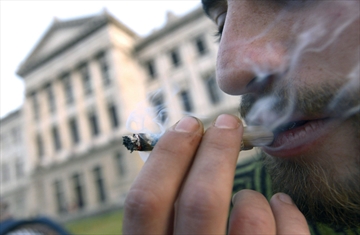Mark Sommerhauser, msommerhauser@stcloudtimes.com
3:25 p.m. CDT May 10, 2014
ST. PAUL – The Minnesota House has voted to legalize medical marijuana for participants in a state research study, setting up talks with the Senate on a compromise bill.
With parent-advocates and their sick children looking on, the House voted 86-39 to pass the bill.
Several
lawmakers choked back tears during a Friday debate that, at times,
turned remarkably personal. Some talked about their own illnesses or
those of loved ones; others touched on their battles with addiction.
"Think about your family, your neighbors," Rep.
Tony Albright, who supported the bill, urged his colleagues.
Most
St. Cloud-area representatives voted against the bill, except Rep.
Zachary Dorholt, a DFLer, and Rep. Tama Theis, a Republican, both of St.
Cloud.
The bill, sponsored by Rep. Carly Melin, DFL-Hibbing, is
far narrower in scope than the medical marijuana bill passed Tuesday by
the Minnesota Senate. It would legalize medical marijuana only for
participants in a Medical Cannabis Therapeutic Research Study run by the
Department of Health. About 5,000 Minnesotans with specified
conditions, such as cancer, seizures or multiple sclerosis, could participate.
A
single, state-approved manufacturer would supply patients with medical
marijuana through two dispensaries under the House proposal. Smoking of
the drug would not be allowed; it could be consumed only in pill or oil form.
Rep. Tama Theis describes marijuana bill decision
Senate bill broader
Gov. Mark Dayton wrote House and Senate lawmakers just after Friday's vote, saying he would sign
the House version of the medical marijuana bill. That could heighten
pressure on senators to concur with the House version; they also could
negotiate a fresh compromise with the House.
The Senate bill would
legalize use — but not smoking — of medical marijuana for all people
with a qualifying health condition, a doctor's recommendation and a
state-issued identification card. It would create a network of 55 medical marijuana dispensaries throughout the state.
Law enforcement
groups have spoken out against the Senate bill but have remained
neutral on the House bill. That's critical because Dayton, who has been
reluctant to sign a medical marijuana bill, has tied his stance closely
to that of law enforcement.
The House measure, scaled back significantly from earlier versions, has split medical marijuana advocates. Most wanted a bill that could benefit more patients and make the drug easier to obtain and administer.
But supporters of the measure, led by Melin, say they're willing to yield to obtain Dayton's signature.
One
of the parents watching Friday's debate in person was Ryan Hiltner of
St. Cloud. His 7-year-old daughter, Amaya, has a severe form of epilepsy
that hasn't responded well to traditional treatment.
The Hiltners say they want the medical marijuana option for Amaya
because others with epilepsy have benefited from certain forms of the
drug.
'We just need something that works'
Hiltner said the House bill
is far from perfect. But Hiltner said he supports the bill because it
would provide a platform to start getting medical marijuana to
Minnesotans who need it.
Proponents "need to respect law enforcement
and they need to respect what Gov. Dayton wants. I think that's what
they're trying to do with this bill," Hiltner said. "At the end of the
day, we just need something that works — and we need it this year."
The personal nature of Friday's debate extended from the House gallery, where the Hiltners were watching, to the House floor.
Rep. Rod Hamilton has multiple sclerosis, one of the conditions that could qualify someone for medical marijuana under the House and Senate bills.
In
an emotional speech to colleagues, Hamilton, R-Mountain Lake, said he
initially opposed medical marijuana but changed his mind after meeting
with parents of children who could benefit from the drug.
Several
area representatives, including Jeff Howe, R-Rockville, Tim O'Driscoll,
R-Sartell, and Tama Theis, R-St. Cloud, said they hadn't decided how
they would vote on the bill until the final moments.
The
first-term Theis said she was trying to balance her concern for patients
with law enforcement concerns and with her own questions about the
workability of the House proposal.
Critics want federal action
After
voting for the bill, Theis said she remains concerned that its paucity
of dispensaries will make it tough for outstate Minnesotans to get the drug.
Still, Theis said she was surprised at the volume of emails she received urging her to support the bill. The fact that law enforcement groups didn't oppose it also was key, she said.
House GOP opponents of the bill said the federal government,
not states, should be looking into whether marijuana has medicinal
uses. They say they want the FDA to treat marijuana like other drugs and
evaluate its efficacy for medical use.
Marijuana remains a Schedule 1 controlled substance under federal law. Critics question what would happen if a future president is hostile to medical use of the drug.
Advocates
say states shouldn't wait for FDA action because the federal
classification of marijuana hinders the research needed for the FDA to
consider it.
O'Driscoll said Minnesota and states that have
legalized medical marijuana should pass resolutions urging federal
officials to remove hurdles to medical marijuana research.
"I acknowledge that we need to do something," O'Driscoll said. "State by state, doing this, isn't going to be the resolution."
HOW THEY VOTED
Here's
how St. Cloud-area representatives voted on a bill to legalize medical
marijuana for those with serious health conditions who participate in a
state research study:
YES
Rep. Zachary Dorholt,
DFL-St. Cloud
Rep. Tama Theis, R-St. Cloud
NO
Rep. Paul Anderson,
R-Starbuck
Rep. Sondra Erickson,
R-Princeton
Rep. Jeff Howe, R-Rockville
Rep. Ron Kresha, R-Little Falls
Rep. Jim Newberger, R-Becker
Rep. Tim O'Driscoll, R-Sartell
Rep. Marion O'Neill,
R-Buffalo


















